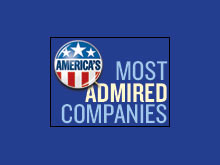How admired companies find the best talent
Procter & Gamble is a veritable CEO factory. How do companies admired for their people management do it? Plus: what impresses these employers.
NEW YORK (FORTUNE) - No doubt about it: The battle for talent is heating up. More companies are hiring, especially at the middle manager level, where the Bureau of Labor Statistics now says unemployment has fallen to 2%, its lowest rate in five years. And more people who already have jobs are looking for new ones. According to a recent survey by Salary.com, a startling 80% of employees are either actively job hunting or open to better offers from elsewhere.
In this labor market, if you're an employer intent on finding and keeping the best people, how do you do it? As part of Fortune's annual ranking of America's Most Admired Companies, a broad cross-section of executives were asked who they believe has an edge when it comes to recruiting and developing talent. The two winners, Procter & Gamble (Research) and General Electric (Research), have long been known for their skill at managing people -- but the rest of the top ten may be a bit more surprising. In descending order, they are: Google (Research), UnitedHealth Group, United Parcel Service (Research), Exelon, Starbucks (Research), FedEx (Research), Anheuser-Busch, Nordstrom, FMC Technologies, Walgreen, Pepsico (Research), Nestle, and BP. What, you might well wonder, could an oil company, a coffee-shop empire, a couple of express-delivery services, a brewer, and a drugstore chain possibly have in common? As it turns out, plenty. First, says Ed Jensen, who runs the global human resources practice at consulting powerhouse Accenture, "You'll find that communication up and down the ranks in these companies is more open, and more frequent, than in other companies. Top management is more accessible, which makes employees at all levels feel engaged in meeting the company's goals." Second, these employers expect excellence from everybody. "They challenge their people early and often, and move them around more than in most companies," Jensen notes. "They don't want anybody to get too comfortable in one job." That plays directly into the third strength these companies share: Instead of grooming only so-called high-potential workers for bigger opportunities, they offer plenty of chances for every employee to learn and grow -- which means that when they need talent, they can find it in-house rather than having to look elsewhere. "Even in tough economic times, when most companies cut back on training and on relocating people to develop their skills, these companies keep right on doing it," Jensen says. "That gives them a broad pool of people to promote. And it helps with retention, too, because employees can see long-term opportunities." Look, for instance, at FedEx and UPS, where more than 90% of senior management started on the loading dock -- often on the night shift, and came up through the ranks. Or consider Procter & Gamble, where CEO Alan "A.G." Lafley started his career in 1977 (after a stint in the Navy and a Harvard MBA) as a marketing assistant for Joy dishwashing liquid. It's no coincidence that P&G's annual turnover is a tiny 2%. "Many of our employees have been here 25 or 30 years. Loyalty isn't dead. It's just changed a bit," says human resources chief Dick Antoine. "The old lifetime-employment guarantee may be gone, but that's okay, because it was almost like a parent-child relationship. We'd rather see it as a business deal between two adults -- and we do promise that we will invest in your career." Antoine is a poster child for P&G's practice of giving newbies big challenges right away. In his first job with the company, straight out of college in 1969, he ran a $20 million Ivory soap operation, managing a staff of 30. Of course, for a promote-from-within culture to work, you have to hire the right people in the first place. P&G, which gets more than one million job applications each year in the U.S. alone, has three Ph.D. psychologists on staff who oversee a rigorous testing process. "We're looking for nine characteristics, which we call success drivers," says Antoine. They include the willingness to embrace change, a knack for collaboration, the ability to execute a plan, and leadership talent. Line managers make all the hiring decisions and, in interviews, they try to elicit examples from candidates of their experience in all nine areas. That selection process -- and the emphasis on developing those drivers -- has helped make P&G, like close runner-up General Electric, a veritable CEO factory. "When people do leave, we stay in touch with them, and they tell us they miss being surrounded by talented, high-energy colleagues," Antoine says. "But we're very proud of our alumni, who tend to do pretty well elsewhere." You might say that. To name just three, who now sit on P&G's board: Boeing CEO James McNerney, Intuit founder and chairman Scott Cook, and Meg Whitman, CEO of eBay. ------------- Friends, for an upcoming story in the magazine, tell me: When and where do you get your best ideas? Think back, if you would, to a time when you needed to solve a complicated business problem or come up with a fresh approach to your job. Did it come to you when you were overworked, overtired, and stressed out -- or when you were rested, relaxed, and maybe not even thinking about work at all? I'd be willing to bet that most of us experience our "Eureka!" moments, those mysterious flashes of insight or creativity, when we're least expecting them -- perhaps while driving, gardening, working out, or even sleeping. If you'd like to tell me about yours, please include the word "ideas" in the subject line of your e-mail. Many thanks! See the full list of America's Most Admired Companies.
Got a question or comment? E-mail me here. |
| |||||||||||||||||||||||||||||||


